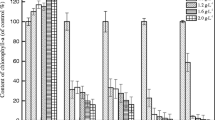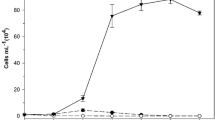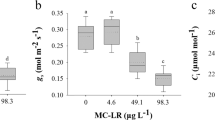Abstract
This study investigated the use of Dracontomelon duperreanum leaf litter extract (DDLLE) in inhibiting the growth and photosynthesis of the algae Microcystis aeruginosa. The goal of the study was to evaluate a potential solution for cyanobacterial bloom prevention. M. aeruginosa was exposed to extract concentrations from 0.4 to 2.0 g L−1. Chlorophyll-a (Chl-a) content and photosynthesis levels were assessed using pulse amplitude modulated fluorimetry phytoplankton analyzer. Results suggested that the extract could efficiently suppress M. aeruginosa growth. The content of Chl-a was only 19.0 µg L−1 and achieved 96.0% inhibition rate when exposed to 2.0 g L−1 on day 15. Growth rate in response to different extract concentrations were consistent with changes in the photosynthesis efficiency (alpha), maximal relative electron transport rate and maximal photochemical efficiency of photosystem II (F v /F m ). Furthermore, several kinds of volatile chemicals and their concentrations in DDLLE had been identified by GC–MS, which of them play major role to suppress the growth of M. aeruginosa should be further studied.




Similar content being viewed by others
References
Daniel ET, Ferrier MD, Armbrester EA, Anlauf KA (2002) Inhibition of dinoflagellate growth by extracts of barley straw (Hordeum vulgare). J Appl Phycol 14:275–280
Ferrier MD, Butler BR, Terlizzi DE, Lacouture R (2005) The effects of barley straw (Hordeum vulgare) on the growth of freshwater algae. Bioresour Technol 96:1788–1795
Gao L, Xie L (2011) Analysis of the influence of meteorological condition on cyanobacterial bloom and treatment methods in Taihu Lake. China Resour Compr Utilization 29:35–38 (In Chinese)
Hong Y, Hu HY, Sakoda A, Sagehashi M (2011) Straw preservation effects of Arundo donax L. on its allelopathic activity to toxic and bloom-forming Microcystis aeruginosa. Water Sci Technol 63:1566–1573
Huang HM, Xiao X, Ghadouani A, Wu JP, Nie Z, Peng YC, Xu XH, Shi JY (2015) Effects of natural flavonoids on photosynthetic activity and cell integrity in Microcystis aeruginosa. Toxins 7:66–80
Jančula D, Maršálek B (2011) Critical review of actually available chemical compounds for prevention and management of cyanobacterial blooms. Chemosphere 85:1415–1422
Jia CS (2006) Calculatiang the LC50 of insecticides with software SPSS. Chin Bull Entomol 43:414–417 (Chinese)
Li FM, Hu HY (2005) Isolation and characterization of a novel anti-algal allelochemical from Phragmites communis. Appl Environ Microbiol 71:6545–6553
Lu ZY, Sha J, Tian Y, Zhang XZ, Liu BY, Wu ZB (2017) Polyphenolic allelochemical pyrogallic acid induces caspase-3 (like)-dependent programmed cell death in the cyanobacterium Microcystis aeruginosa. Algal Res 21:148–155
Macías FA, Oliva RM, Simonet AM, Galindo JCG (1998) What are allelochemicals? In: Olofsdotter M (ed) Allelopathy in Rice. IRRI Press, Manilla
Nakai S, Yamad S, Hosomi M (2005) Anti-cyanobacterial fatty acids released from Myriophyllum spicatum. Hydrobiologia 543:71–78
Paeri HW, Huisman J (2008) Climate-blooms like it hot. Science 320:57–58
Pan Q, Zou GY, Song XF, Nakai SS, Fu ZS (2014) Inhibitory effects of the roots of floating bed plants of Canna indica on Microcystis aeruginosa. Res of Environ Sci 27:193–1198 (Chinese)
Platt T, Gallegos CL, Harrison WG (1980) Photoinhibition of photosynthesis in natural assemblages of marine phytoplankton. J Mar Res 38:687–701
Qian HF, Xu XY, Chen W, Jiang H, Jin YX, Liu WP, Fu ZW (2009) Allelochemical stress causes oxidative damage and inhibition of photosynthesis in Chlorella vulgaris. Chemosphere 75:368–375
Ralph PJ, Gademann R (2005) Rapid light curves: a powerful tool to assess photosynthetic activity. Aquat Bot 82:222–237
Rice EL (1984) Allelopathy, 2nd edn. Academic Press, Orlando
Ridge I, Pillinger JM (1996) Towards understanding the nature of algal inhibitors from barley straw. Hydrobiologia 120:301–305
Ridge I, Walters J, Street M (1999) Algal growth control by terrestrial leaf litter: a realistic tool? Hydrobiologia 395–396:173–180
Rippka R, Deruelles J, Waterbury JB, Herdman M, Stanier RY (1979) Genetic assignments, stain histories and properties of pure culture of cyanobacteria. J Gen Microbiol 111:1–61
Schrader KK, de Regt MQ, Tidwell PR, Turker CS, Duke SO (1998) Selective growth inhibition of the mushy-odour producing cyanobacterium Oscillatria cf. chalybea by natural compounds. Bull Environ Contam Toxicol 60:651–658
Su XF, Nong WT (2010) Study on antimicrobial activity of extracts from Dracontomelon duperreanum. Chin Pharm 21:2115–2117 (Chinese)
Su W, Johannes AH, Jia YH, Lu YP, Kong FX (2014) Effects of rice straw on the cell viability, photosynthesis, and growth of Microcystis aeruginosa. Chin J Oceanol Limn 32:120–129
Suggett DJ, Borowitzka MA, Prášil O (2010) Chlorophyll a fluorescence in aquatic sciences: methods and applications. Springer, London
Wang R, Hua M, Yu Y, Zhang M, Xian QM, Yin DQ (2016a) Evaluating the effects of allelochemical ferulic acid on Microcystis aeruginosa by pulse-amplitude-modulated (PAM) fluorometry and flow cytometry. Chemosphere 147:264–271
Wang XX, Jiang CC, Szeto YT, Li HK, Yam KL, Wang XJ (2016b) Effects of Dracontomelon duperreanum defoliation extract on Microcystis aeruginosa: physiological and morphological aspects. Environ Sci Pollut Res 23:8731–8740
Wang SB, Wang YN, Ma XX, Xu ZR (2016c) Effects of garlic and diallyl trisulfide on the growth, photosynthesis, and alkaline phosphatase activity of the toxic cyanobacterium Microcystis aeruginosa. Environ Sci Pollut Res 23:5712–5720
Xiao X, Chen YX, Liang XQ, Lou LP, Tang XJ (2010) Tibetan hulless barley efficiently inhibited bloom-forming cyanobacterium Microcystis aeruginosa. Chemosphere 81:1118–1123
Zhou SQ, Shao YS, Gao NY, Deng Y, Qiao JL, Ou HS, Deng J (2013) Effects of different algaecides on the photosynthetic capacity, cell integrity and microcystin-LR release of Microcystis aeruginosa. Sci Total Environ 463–464:111–119
Acknowledgements
This work was supported by the National Natural Science Foundation (NSFC) of China, Grant No. 5137836 and the Science, Industry, Trade and Information Technology Commission of Shenzhen Municipality (JCYJ20150430163657307) for their financial support.
Author information
Authors and Affiliations
Corresponding author
Rights and permissions
About this article
Cite this article
Wang, X., Szeto, Y.T., Jiang, C. et al. Effects of Dracontomelon duperreanum Leaf Litter on the Growth and Photosynthesis of Microcystis aeruginosa. Bull Environ Contam Toxicol 100, 690–694 (2018). https://doi.org/10.1007/s00128-018-2289-5
Received:
Accepted:
Published:
Issue Date:
DOI: https://doi.org/10.1007/s00128-018-2289-5




